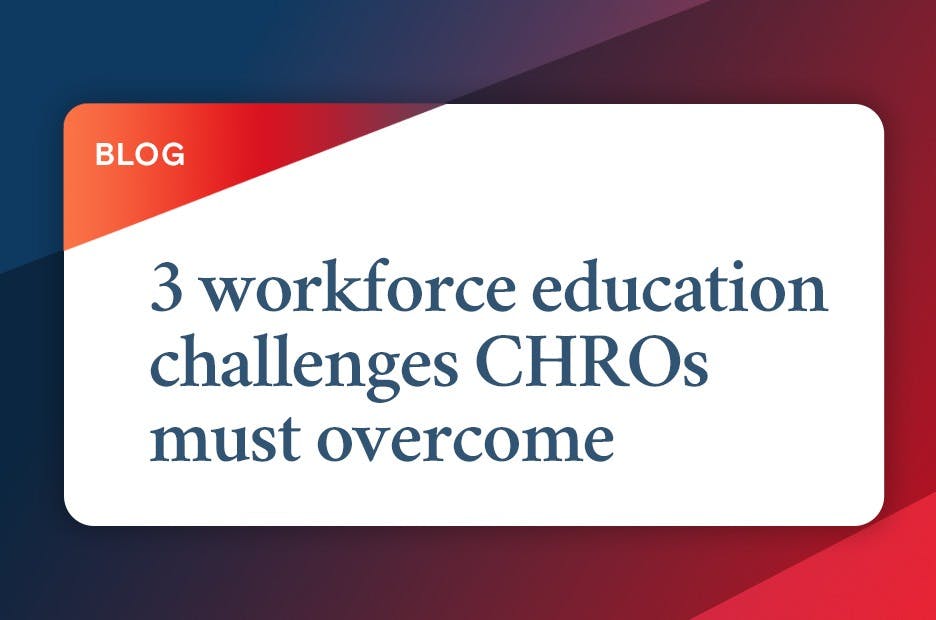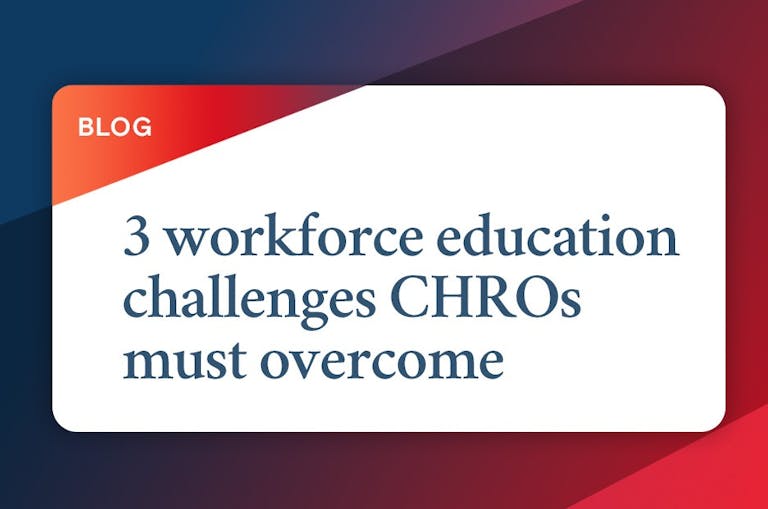“Tuition-assistance programs reduce employee turnover and help businesses identify their most productive workers,” Peter Cappelli, director of the Center for Human Resources at the University of Pennsylvania’s Wharton School, shared in a recent Better Workplaces, Better World article.
However the article also points out that, "Overall, relatively few employees take advantage of tuition aid. Fewer than 10 percent of workers at companies that offer tuition reimbursement use the benefit annually, according to a recent estimate by Willis Towers Watson."
The reasons for this discrepancy are one of three challenges around education programs that chief human resource officers (CHROs) must overcome.
To build the kind of modern workforce required for businesses to thrive in the future, your organization needs engaged, continuously learning employees who intend to stay and grow with your company. How is your organization rising to this challenge? Strategic enterprise educationTM—the custom approach to workforce training that gives employee-learners access to education and skill-building courses that meet your business goals—is the most effective way to make this a reality.
Let’s look at three key challenges CHRO’s must consider as you lead your organization to design, manage and market a strategic enterprise education program. Overcoming these hurdles is key to delivering education that actually retains employees, improves skills, strengthens your brand and drives your organization toward a sustainable future.
No. 1: Align your program to business needs and employee motivations
The first challenge lies within the design of an enterprise education program. It’s essential to make sure your strategy aligns to two critical components: the needs of your business and the motivations of your employees.
Too many business leaders find their organizations bogged down by legacy initiatives such as tuition assistance, corporate learning, scholarships and training programs that are not designed with the organization’s current strategic goals in mind.
Many of these workforce education programs fail because they’re not in tune with the needs and preferences of working adults. While 80 percent of employees want to go to school while working, tuition assistance programs (TAPs) generate employee participation rates of only 2 percent.
To actually close skill gaps, boost hiring and retention and improve your employee experience and brand, you need a program that provides access to top-tier academic institutions and career advancement pathways that are the right fit for your workforce. This requires a custom, curated approach that’s also flexible and agile. One-size-fits-all traditional learning and education programs don’t appeal to employees or provide the training that will actually help their careers and your business.
No. 2: Manage the program for business efficiency and maximum learner engagement
Designing the right program is the first step, but equipping your organization to successfully market, enroll and support learner success is the second big challenge.
Running a custom, multifaceted workforce education program requires HR and learning leaders to manage learner eligibility, enrollment, applications and more. Most Human Resources (HR) teams are not built for this set of requirements and need to be focused on your overall business strategy for workforce development and talent success.
Your education program also needs maximum awareness and support to make sure your learners don’t just know about the benefits of the program, but take initiative to start the program and stick with it to completion or graduation. With traditional tuition assistance programs, only about 40 percent of employees are even aware of the education opportunities provided by their employers, and only 25 percent of those who are interested ever start an application. Filling out applications, completing financial aid forms and locating transcripts pose difficult barriers. This is why effective support is critical—not only to optimize your business, but to ensure learners are supported and equipped to participate.
No. 3: Leverage the program to measure ROI and social impact
The third challenge, and one that many CHROs miss, is the follow-through: leveraging the success of your education program to prove ROI to shareholders and demonstrate social impact. Education programs present a significant opportunity to transform brand perception, drive business and attract top talent, investors and partners.
This is where data comes into play. You need to know which and how many employees are using your program, the types of courses they’re taking and how they’re tracking toward graduation. Without these insights, it’s difficult to not only manage an education program or maintain ongoing optimizations, but also to properly market it.
The most effective strategic enterprise education programs provide visibility into employee participation and progress to recognize and celebrate employee accomplishments and share them with your community. You’ll be able to further establish your organization’s employer brand as a place employees can expand their skills and grow—and an organization that cares about making an impact on the world.
Overcome barriers by choosing an expert partner
To solve these challenges effectively and efficiently, you need a strategic partner that can provide expert support in designing, managing and marketing your strategic enterprise education program. As the pioneering leader of this approach with proven results in learner engagement, hiring, retention and social impact, InStride is here to help.
We built our approach and solution to overcome these top challenges with:
- Strategic design by experts from both business and academia
- A top-tier global network of academic institutions that provide options and pathways for various degrees, skill training and industry insights
- An excellent user experience through a white-labeled, turnkey technology platform
- Top-notch engagement — driving 80 percent of employees to explore the program website in the very first month
- Direct corporate billing that reduces burdens on both HR admin and employees
- Data and reporting to monitor learner progress and communicate results
- Marketing support to share your success with the world
If you’d like to learn more about building the workforce of the future through a turnkey approach to attracting and retaining top talent, reskilling and upskilling your organization, and driving brand awareness and social impact, talk with one of our experts today.

